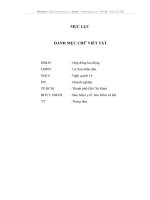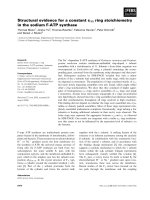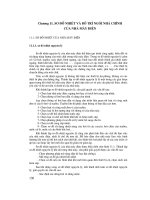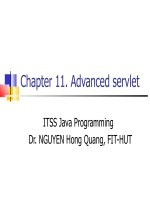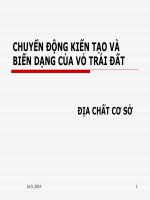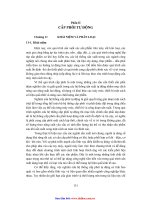C1101 c11
Bạn đang xem bản rút gọn của tài liệu. Xem và tải ngay bản đầy đủ của tài liệu tại đây (20.63 KB, 2 trang )
Designation: C 1101/C1101M – 95
Standard Test Methods for
Classifying the Flexibility or Rigidity of Mineral Fiber
Blanket and Board Insulation1
This standard is issued under the fixed designation C 1101/C1101M; the number immediately following the designation indicates the
year of original adoption or, in the case of revision, the year of last revision. A number in parentheses indicates the year of last
reapproval. A superscript epsilon (e) indicates an editorial change since the last revision or reapproval.
6. Sampling
6.1 A test sample shall consist of one representative package
of insulation. One test specimen measuring 12 in. by 12 in.
[305 by 305 mm] and of full thickness shall be randomly cut
from the sample for flexibility testing. If the rigidity portion of
the procedure is to be performed, a test specimen measuring 32
in. [813 mm] long, and between 6 and 24 in. [152 and 610 mm]
wide, and of full thickness shall be randomly cut from the
sample.
1. Scope
1.1 These test methods cover the procedures for the classification of mineral fiber insulation as flexible, resilient flexible,
semirigid, or rigid.
1.2 The values stated in either inch-pound units or SI units
are to be regarded separately as standard. Within the text, the
SI units are shown in brackets. The values stated in each
system are not exact equivalents; therefore, each system must
be used independently of the other.
1.3 This standard does not purport to address all of the
safety concerns, if any, associated with its use. It is the
responsibility of the user of this standard to establish appropriate safety and health practices and determine the applicability of regulatory limitations prior to use.
7. Procedure
7.1 Test for Flexibility—Bend the 12 by 12-in. [305 by
305-mm] piece of insulation over the 1⁄2 in. NPS iron pipe
through an angle of 90° and examine the outer surface for
visible rupture.
7.2 Test for Resilient Flexibility—If no rupture occurs after
undergoing the 90° bending in 7.1, release the bent insulation.
7.3 If the insulation is not classified as flexible or resilient
flexible, it should be tested in accordance with 7.4 to determine
the degree of rigidity.
7.4 Test for Semirigidity and Rigidity—Place the 32 in. [813
mm] long piece of insulation on the two horizontal, parallel,
1⁄2-in. NPS iron pipe supports spaced 30 in. [762 mm] apart.
After 5 min have elapsed, measure the sag of the insulation to
the nearest 0.05 in. [1.3 mm] at the center of the span, from a
straight line connecting two points on the insulation’s surface
directly above the supports.
2. Referenced Documents
2.1 ASTM Standards:
C 168 Terminology Relating to Thermal Insulating Materials2
3. Terminology
3.1 Definitions—Terminology C 168 shall be considered as
applying to the terms used in these test methods.
4. Significance and Use
4.1 Classification of insulation relative to flexibility or
rigidity is useful in establishing installation and application
characteristics.
8. Interpretation of Results
8.1 Test for Flexibility—If there is no visible rupture,
classify the material as flexible.
8.2 Test for Resilient Flexibility—If the insulation is classified as flexible in accordance with 8.1 and it springs back to its
original form when it is released, classify it as resilient flexible.
8.3 Test for Semirigidity:
8.3.1 If the sag is greater than 1⁄2 in. [13 mm], the product is
classified as semirigid.
8.3.2 If the test material fails to remain suspended, it is
neither semirigid nor rigid and must be classified by the
flexibility test as flexible or resilient flexible.
8.4 Test for Rigidity—If, after undergoing the test in 7.4, the
sag is 1⁄2 in. [13 mm] or less, the product is classified as rigid.
8.5 Due to the accuracy of the sag measurements, at the
5. Apparatus
5.1 Iron Pipe, 1⁄2-in. NPS (outside diameter 0.840 in. [21.3
mm]) measuring at least 12 in. [305 mm] in length.
5.2 Rigidity Tester, consisting of two horizontal, parallel,
1⁄2-in. NPS iron pipe supports (outside diameter 0.840 in. [21.3
mm]) at least 24 in. [610 mm] long and spaced 30 in. [762 mm]
apart and horizontally to each other.
1
These test methods are under the jurisdiction of ASTM Committee C-16 on
Thermal Insulation and are the direct responsibility of Subcommittee C16.32 on
Mechanical Properties.
Current edition approved Jan. 15, 1995. Published March 1995. Originally
published as C 1101/C 1101M – 88. Last previous edition C 1101/C 1101M – 88.
2
Annual Book of ASTM Standards, Vol 04.06.
Copyright © ASTM, 100 Barr Harbor Drive, West Conshohocken, PA 19428-2959, United States.
1
C 1101/C1101M
rigid-semirigid break point of 1⁄2 in. [13 mm], there is an
uncertainty of 0.05 in. [1.3 mm]. Therefore, for sag measurements in this “gray area,’’ the test may not be valid. Greater
accuracy may be attained by taking very careful sag measurements or by repeating the test several times.
9.2 The precision of these test methods is not known
because inter-laboratory data are not available. These test
methods may not be suitable for use in specifications or in case
of disputed results as long as these data are not available.
10. Keywords
9. Precision and Bias
9.1 The precision and bias for the procedure in Test Methods C 1101/C 1101M for classifying the flexibility or rigidity
of mineral fiber blanket and board are being determined.
10.1 flexibility; mineral fiber; resilient flexibility; rigidity;
semirigidity; thermal insulation
The American Society for Testing and Materials takes no position respecting the validity of any patent rights asserted in connection
with any item mentioned in this standard. Users of this standard are expressly advised that determination of the validity of any such
patent rights, and the risk of infringement of such rights, are entirely their own responsibility.
This standard is subject to revision at any time by the responsible technical committee and must be reviewed every five years and
if not revised, either reapproved or withdrawn. Your comments are invited either for revision of this standard or for additional standards
and should be addressed to ASTM Headquarters. Your comments will receive careful consideration at a meeting of the responsible
technical committee, which you may attend. If you feel that your comments have not received a fair hearing you should make your
views known to the ASTM Committee on Standards, 100 Barr Harbor Drive, West Conshohocken, PA 19428.
This standard is copyrighted by ASTM, 100 Barr Harbor Drive, West Conshohocken, PA 19428-2959, United States. Individual
reprints (single or multiple copies) of this standard may be obtained by contacting ASTM at the above address or at 610-832-9585
(phone), 610-832-9555 (fax), or (e-mail); or through the ASTM website ().
2


